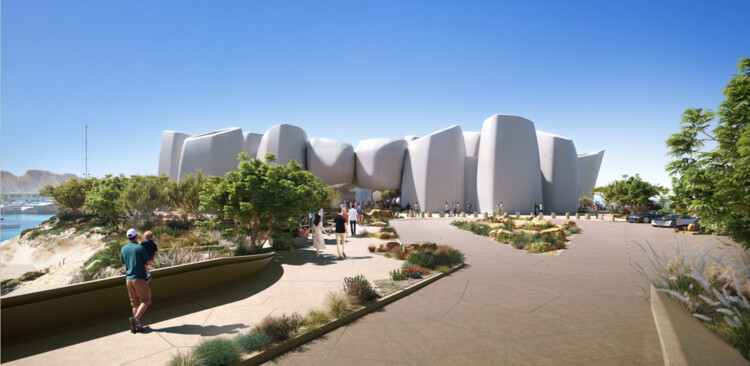
Foster + Partners has revealed the designs of the Marine Life Institute on Saudi Arabia's northwestern coast. As part of Triple Bay development AMAALA, a luxury tourist destination on the Red Sea coastline, the project will accommodate a research center, labs, galleries, and educational spaces to give visitors a glimpse into the wonders of the marine environment of the coastline. Reproducing the forms of coral formations, the building will be the world's first fully immersive marine institution where visitors can walk underwater, snorkel with rare species and experience a coral exhibit inside the building.
Located in the Triple Bay Marina at AMAALA, a megaproject of 6.5 kilometers on the Red Sea coastline, the site stands out for its natural diversity and heritage that offers several geological and historical sites, such as Madain Saleh and Al-Ula. Further, the Red Sea Coral Reef provides a protected ecosystem, one of the world's remaining pristine marine ecosystems. The Marine Life Institute is part of the Triple Bay master plan by HKS Architects, which aims to become the newest destination on the jet-setter map and boost domestic tourism on Saudi Arabia's northwestern coast.

The Marine Life institute comprises three floors: above ground, below ground, and underwater. At the heart of the building, a suspended semi-spherical tank will contain local marine wildlife within a coral exhibit. In addition to the immersive exhibition spaces, the architecture program is distributed around different circulation levels for researcher-led laboratories' educational tours and underwater guided Red Sea tours in submersible vehicles.
The exhibition displays are integrated with the architecture of the building. Illustrating the journey through the Red Sea – from shallow mangroves and sandy beaches to the immersive deep reef– large tanks flank visitors as they travel through the building into the ocean. The lighting throughout the institute is designed with an innovative framework to prevent light pollution from protecting the nocturnal environment.

The structure is made of GRC panels, robust in the marine environment, to emulate the shape and texture of coral formations. A structural steel frame supports the panels to maintain lightweight construction, forming a central canopy that spans all four of the building's clusters providing shading and ventilation. Native plants cover more than 40 percent of the site, and a system to collect runoff water prevents erosion and pollution while reducing the complex's water use.

In addition to the Marine Life Institute, Foster + Partners has completed the new headquarters for the National Bank of Kuwait, a 300-meter skyscraper with a distinctive presence among the buildings of Sharq. The firm is also developing the new Red Sea Airport, which is expected to welcome one million visitors by 2030. The airport’s design is inspired by desert dunes to create the form of the roof shells and will accommodate an internal green oasis to provide a new type of experience, diverging from the common hassles of airports.





